
German postcard by Ross Verlag, no. 4617/1, 1929-1930. Photo: Paramount.
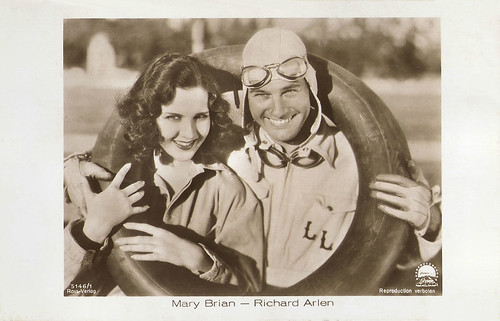
German postcard by Ross Verlag, no. 5146/1, 1930-1931. Photo: Paramount. Mary Brian and Richard Arlen in Burning Up (A. Edward Sutherland, 1930).
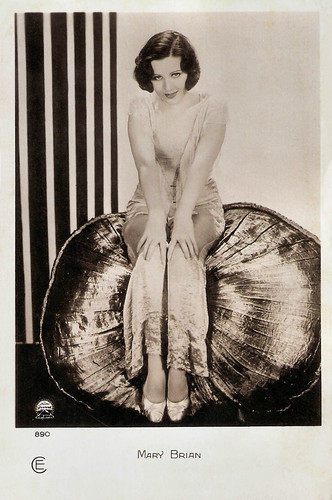
French postcard by Cinémagazine-Sélection, Paris, no. 890. Photo: Paramount.
Wendy Darling
Mary Brian was born Louise Byrdie Dantzler, in Corsicana, Texas, in 1906. She was the daughter of Taurrence J. Dantzler and Louise B. Dantzler. Her brother was Taurrence J. Dantzler, Jr. Her father died when she was one month old and the family later moved to Dallas.
In the early 1920s, they moved to Long Beach, California. Mary had intended to become an illustrator but that was laid aside when at age 16 she was discovered in a local bathing beauty contest. One of the judges was famous film star Esther Ralston who was to play her mother in the upcoming Peter Pan (1924) and who became a lifelong friend. She didn't win the $25 prize in the contest but Ralston said, "you've got to give the little girl something."
So, her prize was to be interviewed by director Herbert Brenon for a role in Peter Pan (1924). Brenon was recovering from eye surgery, and she spoke with him in a dimly lit room. "He asked me a few questions, Is that your hair? Out of the blue, he said, I would like to make a test. Even to this day, I will never know why I was that lucky. They had made tests of every ingénue in the business for Wendy. He had decided he would go with an unknown. It would seem more like a fairy tale. It wouldn't seem right if the roles were to be taken by someone they (the audience) knew or was divorced. I got the part. They put me under contract."
The studio renamed her Mary Brian and cast her as Wendy Darling in the silent film version of J. M. Barrie's Peter Pan (Herbert Brenon, 1924). There she starred with Betty Bronson and Esther Ralston, and the three of them stayed close for the rest of their lives. Ralston described both Bronson and Brian as 'very charming people'.
The studio said she was age 16 instead of 18, because the latter sounded too old for the role, then signed her to a long-term motion picture contract. Brian played Fancy Vanhern, daughter of Percy Marmont, in Brenon's The Street of Forgotten Men (Herbert Brenon, 1925), which had newcomer Louise Brooks in an uncredited debut role as a moll.

Spanish postcard by EFR (Editorial Fotografica, Barcelona), no. A 83.
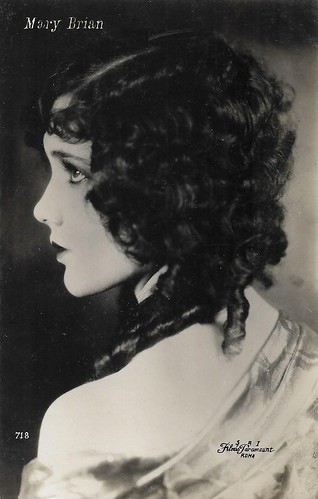
Italian postcard by Ballerini & Fratini, Firenze, no. 718, Photo: Films Paramount, Roma.

French postcard by Cinémagazine-Sélection, Paris, no. 787. Photo: Paramount.

Austrian postcard by Iris Verlag, no. 5600. Photo: Paramount.
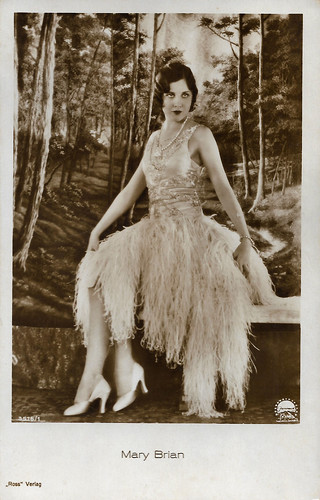
German postcard by Ross Verlag, no. 3515/1, 1928-1929. Photo: Paramount.
One of the WAMPAS Baby Stars in 1926
Mary Brian was dubbed "The Sweetest Girl in Pictures." On loan-out to MGM, she played a college belle, Mary Abbott, opposite William Haines and Jack Pickford in the drama Brown of Harvard (Jack Conway, 1926). It was also John Wayne's film debut.
She was named one of the WAMPAS Baby Stars in 1926, along with Mary Astor, Dolores Costello, Joan Crawford, Dolores del Río, Janet Gaynor, and Fay Wray. During her years at Paramount, Brian appeared in more than 40 films as the lead, the ingenue or co-star.
She worked with Brenon again when she played Isabel in P. C. Wren's Beau Geste (Herbert Brenon, 1926) starring Ronald Colman. That same year she made the war comedy Behind the Front (Eddie Sutherland, 1926) with Wallace Beery, and Paris at Midnight (E. Mason Hopper, 1926) starring Jetta Goudal.
In 1928, she played ingenue Alice Deane in Forgotten Faces (Ewald André Dupont, 1928) opposite Clive Brook as her sacrificing father, Olga Baclanova as her vixen mother and William Powell as Froggy.
Brian's first sound film was Varsity (Frank Tuttle, 1928), with part-sound and talking sequences, opposite Buddy Rogers. After successfully making the transition to sound, she co-starred with Gary Cooper, Walter Huston and Richard Arlen in one of the earliest Westerns with sound, The Virginian (Victor Fleming, 1929). In it, she played a spirited frontier heroine, schoolmarm Molly Stark Wood, who was the love interest of the Virginian (Cooper).

German postcard by Ross Verlag, no. 4673/2, 1929-1930. Photo: Paramount.

German postcard by Ross Verlag, no. 5147/1, 1930-1931. Photo: Paramount. Collection: Geoffrey Donaldson Institute.

German postcard. by Ross Verlag, no. 5403/1, 1930-1931. Photo: Paramount. Mary Brian and Richard Arlen in The Light of the Western Stars (Otto Dyar, 1930).

German postcard by Ross Verlag, no. 5549/1, 1930-1931. Photo: Paramount.

German postcard by Ross Verlag, no. 5553/1, 1930-1931. Photo: Paramount. Mary Brian and Richard Arlen in the car-racing drama Burning Up (A. Edward Sutherland, 1930).
A thinly disguised caricature of the private lives of the Barrymore dynasty
Mary Brian co-starred in several hits during the 1930s. She played Gwen Cavendish in George Cukor’s comedy The Royal Family of Broadway (1930) with Ina Claire and Fredric March. A thinly disguised caricature of the private lives of the Barrymore dynasty, it hit the mark to the extent that Ethel Barrymore even threatened to sue Paramount.
Brian then appeared as herself in Paramount's all-star revue Paramount on Parade (Edmund Goulding, a.o., 1930), as Peggy Grant in Lewis Milestone’s comedy The Front Page (1931) with Adolphe Menjou and Pat O'Brien.
After her contract with Paramount ended in 1932, Brian decided to freelance, which was unusual in a period when multi-year contracts with one studio were common. That same year, she appeared on the vaudeville stage at New York's Palace Theatre. Also in the same year, she starred in Manhattan Tower.
She received top billing for her role as Murial Ross, aka Murial Rossi, in Shadows of Sing Sing (Phil Rosen, 1933). Arguably her last good picture was the romantic comedy Hard to Handle (Mervyn LeRoy, 1933), with James Cagney as a grifter.
Other film roles include Gloria Van Dayham in College Rhythm (Norman Taurog, 1934), Yvette Lamartine in Charlie Chan in Paris (Lewis Seiler, 1935) with Warner Oland, Hope Wolfinger, W. C. Fields’s daughter, in Man on the Flying Trapeze (Clyde Bruckman, 1935), Sally Barnaby in Spendthrift (Raoul Walsh, 1936) opposite Henry Fonda, and Doris in Navy Blues (Ralph Staub, 1937), in which she received top billing.
In 1936, she went to England and made three films, including The Amazing Quest of Ernest Bliss (Alfred Zeisler, 1936) in which she starred opposite Cary Grant, to whom she became engaged at one stage. Her final film of the 1930s was Affairs of Cappy Ricks (Ralph Staub, 1937) although she auditioned unsuccessfully for the part that would go to Janet Gaynor in A Star is Born (William A. Wellman, 1937).

Italian postcard by Cinema-Illustrazione, Milano, series 1, no. 1. Photo: Paramount.
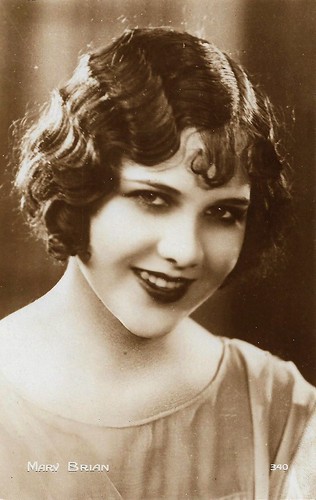
French postcard by Editions Cinémagazine, no. 340.

Belgian postcard. Photo: Paramount. Mary Brian in Burning Up (A. Edward Sutherland, 1930).

French postcard by Edition Ross, no. 5549/1, 1930-1931. Photo: Paramount.
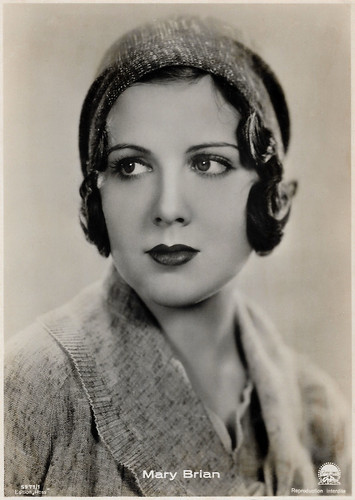
French postcard by Edition Ross, no. 5971/1, 1930-1931. Photo: Paramount.
On the Enola Gay
When World War II hit in 1941, Mary Brian began travelling to entertain the troops, ending up spending most of the war years travelling the world with the U.S.O., and entertaining servicemen from the South Pacific to Europe, including Italy and North Africa.
Commenting on those events that had occurred over fifty years ago, she said in 1996, I was with Charlie Ruggles in Okinawa. And I was on the island of Tinian when they dropped the atomic bomb. Colonel Paul Tibbets, who was the pilot and the officer in charge of dropping the bomb took Charlie and me on the plane the next day, and nobody had been allowed in that encampment. So I was on the Enola Gay.
Flying to England on a troop shoot, Mary got caught in the Battle of the Bulge and spent the Christmas of 1944 with the soldiers fighting that battle. She made several pictures for Poverty Row companies such as Majestic and Monogram, including the low-budget potboiler I Escaped from the Gestapo (Harold Young, 1943) with Dean Jagger and John Carradine.
Her last performance on the silver screen was in Dragnet (Leslie Goodwins, 1947), a B-movie in which she played Anne Hogan opposite Henry Wilcoxon. Over the course of 22 years, Brian had appeared in more than 79 films. Like many 'older' actresses, during the 1950s Brian created a career for herself in television. Perhaps her most notable role was playing the title character's mother in Meet Corliss Archer in 1954.
After her acting years were over, Mary Brian dedicated much time to portrait painting. Though she was engaged numerous times and was linked romantically to numerous Hollywood men, including Cary Grant and silent film actor Jack Pickford, Brian had only two husbands: magazine illustrator Jon Whitcomb (for six weeks in 1941) and film editor George Tomasini (from 1947 until his death in 1964).
After retiring from the screen for good, she devoted herself to her husband's career. Tomasini worked as film editor for Alfred Hitchcock on the classics Rear Window (1954) and Psycho (1960). Mary Brian died of natural causes in 2002 at a retirement home in Del Mar, California at the age of 96. She is interred in the Eternal Love Section at the Hollywood Hills Cemetery, Los Angeles, overlooking Burbank.

British postcard, perhaps in the Picturegoer Series, no. 267 C.

British postcard in the Picturegoer Series, London, no. 267.
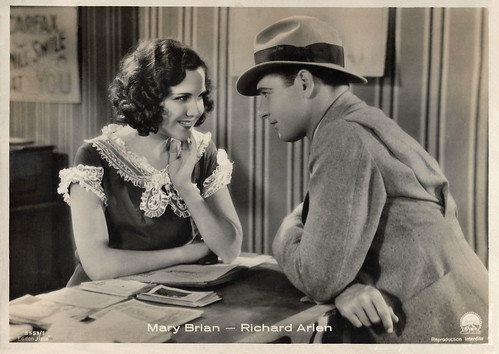
French postcard by Edition Ross, no. 3553/1. Photo: Paramount. Mary Brian and Richard Arlen in the car-racing drama Burning Up (A. Edward Sutherland, 1930).
Sources: I.S. Mowis (IMDb), Wikipedia and IMDb.
No comments:
Post a Comment